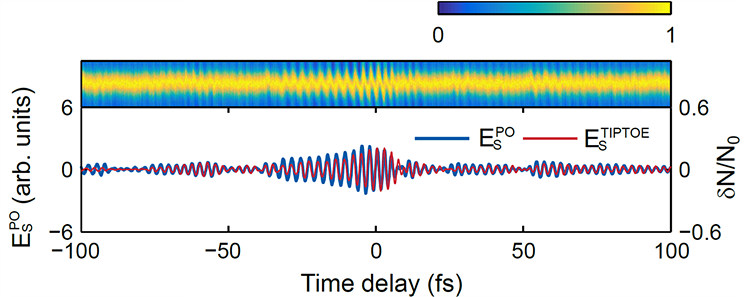주메뉴
- About IBS 연구원소개
-
Research Centers
연구단소개
- Research Outcomes
- Mathematics
- Physics
- Center for Underground Physics
- Center for Theoretical Physics of the Universe (Particle Theory and Cosmology Group)
- Center for Theoretical Physics of the Universe (Cosmology, Gravity and Astroparticle Physics Group)
- Dark Matter Axion Group
- Center for Artificial Low Dimensional Electronic Systems
- Center for Theoretical Physics of Complex Systems
- Center for Quantum Nanoscience
- Center for Exotic Nuclear Studies
- Center for Van der Waals Quantum Solids
- Center for Relativistic Laser Science
- Chemistry
- Life Sciences
- Earth Science
- Interdisciplinary
- Center for Neuroscience Imaging Research (Neuro Technology Group)
- Center for Neuroscience Imaging Research (Cognitive and Computational Neuroscience Group)
- Center for Algorithmic and Robotized Synthesis
- Center for Genome Engineering
- Center for Nanomedicine
- Center for Biomolecular and Cellular Structure
- Center for 2D Quantum Heterostructures
- Institutes
- Korea Virus Research Institute
- News Center 뉴스 센터
- Career 인재초빙
- Living in Korea IBS School-UST
- IBS School 윤리경영


주메뉴
- About IBS
-
Research Centers
- Research Outcomes
- Mathematics
- Physics
- Center for Underground Physics
- Center for Theoretical Physics of the Universe (Particle Theory and Cosmology Group)
- Center for Theoretical Physics of the Universe (Cosmology, Gravity and Astroparticle Physics Group)
- Dark Matter Axion Group
- Center for Artificial Low Dimensional Electronic Systems
- Center for Theoretical Physics of Complex Systems
- Center for Quantum Nanoscience
- Center for Exotic Nuclear Studies
- Center for Van der Waals Quantum Solids
- Center for Relativistic Laser Science
- Chemistry
- Life Sciences
- Earth Science
- Interdisciplinary
- Center for Neuroscience Imaging Research (Neuro Technology Group)
- Center for Neuroscience Imaging Research (Cognitive and Computational Neuroscience Group)
- Center for Algorithmic and Robotized Synthesis
- Center for Genome Engineering
- Center for Nanomedicine
- Center for Biomolecular and Cellular Structure
- Center for 2D Quantum Heterostructures
- Institutes
- Korea Virus Research Institute
- News Center
- Career
- Living in Korea
- IBS School
News Center
| Title | Detecting the Shape of Laser Pulses from Escaped Electrons | ||
|---|---|---|---|
| Embargo date | 2018-05-17 16:00 | Hits | 3446 |
| Research Center |
Center for Relativistic Laser Science |
||
| Press release | |||
| att. | |||
Detecting the Shape of Laser Pulses from Escaped Electrons- New method uses tunnel ionization A team of researchers at the Center for Relativistic Laser Science, within the Institute for Basic Science (IBS) have developed a method to measure the shape of laser pulses in ambient air. Unlike conventional strategies, it is does not require a vacuum environment and can be applied to laser beams of different wavelengths (UV, visible or longer). This patented technique, currently available for technology transfer and commercialization, has now been published in Optica, and it is expected to accelerate studies on light-matter interaction. Experts aim to employ laser light to control the behavior of the electrons, and potentially to manipulate electric currents. However, in order to reach these goals, it is essential to know the waveform of a laser pulse. As molecular events occur in just attoseconds (1 as = 10-18 seconds), the existing method to study them relies on the generation of attosecond X-ray pulses which requires detection equipment in vacuum chambers. IBS researchers devised an alternative approach called TIPTOE (tunneling ionization with a perturbation for the time-domain observation of an electric field) which needs neither X-rays pulses nor vacuum conditions. TIPTOE is based on two superimposed laser pulses: a strong one and a weak one. Atoms or molecules exposed to intensive electric fields, like the ones created by strong laser pulses, can lose some of their electrons in a phenomenon called tunnel ionization. The TIPTOE method depends on the intensity of the electric field and the tunnel ionization of the electrons of the atoms in the air. Time differences between the strong and the weak superimposed laser pulses cause the electric field intensity to vary. As a higher electric field intensity corresponds to higher ionization, changes in the electric field are directly reflected on the tunnel ionization. And in turn, these changes in tunnel ionization are used to measure the shape of the laser pulse. Since tunneling ionization lasts only 200 attoseconds, the TIPTOE method can provide enough temporal resolution to measure UV, visible, and longer wavelength pules. IBS scientists validated TIPTOE by comparing it with the conventional X-ray pulse generation technique, and the results were the same. “TIPTOE’s biggest advantage is the universality of this technique at different wavelengths,” explains Kyung Taec Kim, the leading author of this study.
Notes for editors - References - Media Contact - About the Institute for Basic Science (IBS) |
|||
|
|
|||
| Next | |
|---|---|
| before |
- Content Manager
- Communications Team : Kwon Ye Seul 042-878-8237
- Last Update 2023-11-28 14:20













